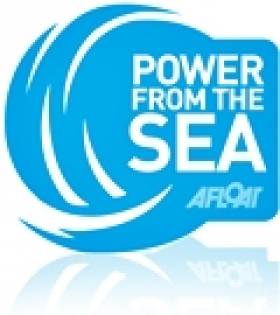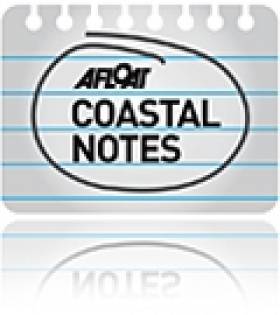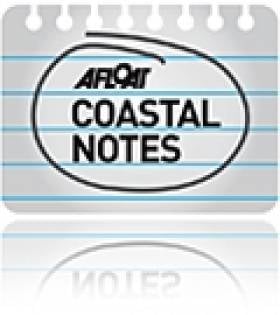Displaying items by tag: renewable energy
Dublin Array Developer Applies for Foreshore Lease
A foreshore lease application has been lodged for a series of offshore wind farms in Dublin Bay.
The Dublin Array, to be situated on the Bray and Kish Banks some 10km from the coast, would consist of 145 turbines, each 160m high, operated by Saorgus Energy Ltd.
The project has been criticised by the Coastal Concern Alliance due to its approval in contravention of an EU directive that requires a strategic environmental assessment.
Further details are available at www.saorgus.com and www.coastalconcern.ie.
'Underwater Kite' a Clean Energy Solution
An 'underwater kite' developed by a Swedish company could be a simple answer to harnessing the power of the sea, The Local reports.
The Deep Green device looks like a toy kite with a turbine attached. But when tethered to the seabed and carried by the ocean currents, it can harness energy at a much more efficient rate - 800 times greater - than surface-based turbines.
Minesto, the company behind the project, claims it can generate 500 kilowatts of power even in calm conditions.
A scale model of the Deep Green system, which was included in Time Magazine's 50 Best Inventions of 2010, will be unveiled later this year off the coast of Northern Ireland.
It will provide an opportunity for testing in real ocean conditions, as well as evaluating the potential impact on marine life below the surface.
“We are confident once successful trials have been carried out for it to be commercially operative by 2013,” said Minesto CEO Anders Jansson.
Sweden's The Local has more on the story HERE.
Belfast Invests in Port's Future
Belfast Harbour's new corporate plan details investments worth £92m (€103m) in improving the port and supporting renewable energy.
Handy Shpping Guide reports that the single biggest investment in the three-year-plan is a £40m (€44.7m) scheme for a logistics terminal to support offshore wind farms in the Irish Sea.
While the port acknowledges that the economic downturn means only marginal growth is forecast for tonnages through the Port of Belfast, it says "significant opportunities" exist in diversitying into other sectors such as the 'green economy'.
Belfast Harbour commercial director Joe O’Neill says the corporate plan also "sets the framework" for future development and expansion of the port over the next 20 years.
Licences Sought for WestWave Energy Project
ESB International is seeking foreshore liecences to develop a new wave energy project on the west coast.
The Irish Times reports that the scheme is part of a strategy to generate 150MW of electricy from the sea by 2020, in tandem with the Government's target of 500MW in the same timeframe.
The company hopes to conduct marine surveys for its WestWave project - a collaboration with various wave energy partners - at Killard Point in Co Clare and Achill in Co Mayo, with a view to begin generating power as soon as 2015.
ESB International says the two sites were chosen after a “detailed selection process based on mapping studies, site testing, environmental considerations and stakeholder feedback”.
The project has already secured €4.5m in EU funding approved by EU commissioner for research and innovation Máire Geoghegan-Quinn.
The Irish Times has more on the story HERE.
Renewable Energy Firms Plan Tidal Array in Wales
Two renewable energy companies have applied for planning permission to install a tidal turbine array off the Welsh coast.
Energy Efficiency News reports that the 10MW array commissioned by RWE npower renewables would consist of seven SeaGen turbines from UK-based Marine Current Turbines (MCT), enough to generate energy for 10,000 homes.
The windmill-like turbines would be installed 1km off Anglesey in north Wales between Skerries and Carmel Head and be operational by 2015.
SeaGen turbines are already operating in Northern Ireland's Strangford Narrows, an installation accredited by Ofgen as Britain's first tital power plant. MCT is also working with ESB International on a 100MW project off the Antrim coast.
The Welsh Assembly has set a target of capturing 10% of tidal and wave energy off the Welsh coast by 2025 as part of its renewable energy plan.
Energy Efficiency News has more on the story HERE.
World's Largest Kite-Powered Vessel On The Way
Cargill Ocean Transportation has signed on with an innovative new company to launch the world's largest ever kite-propelled vessel. (Scroll down for Video)
The Hamburg-based company SkySails claims its technology can generate enough propulsion to reduce fuel consumption by up to 35% in ideal sailing conditions.
SkySails' system uses a computer-controlled kite connected by rope, flying between 100m and 420m in a figure-of-eight. The auomated system steers and adjusts the kite to maximise the wind benefits and requires minimal action by crew.
At the end of this year Cargill plans to install a 320sqm kite on a chartered handysize ship with a view to full operation by early 2012.
The firm intends to partner on the project with "a shipowner supportive of ennironmental stewardship in the industry".
Scotland To Host World's Biggest Tidal Power Array
Scotland's west coast will be home to the world's largest tidal power facility, it has been announced.
The £40 million (€45.9 million) 10MW tidal array, to be developed by ScottishPower Renewables in the Sound of Islay, will generate power for more than 5,000 homes.
Scottish Cabinet Secretary for Finance John Swinney, who signed off on the deal, described the project as "a milestone in the global development of tidal energy".
"Scotland's seas have unrivalled potential to generate green energy, create new, low carbon jobs, and bring billions of pounds of investment to Scotland," he said.
The project comes in tandem with the consultation process for the Scottish government's National Marine Plan, intended to highlight the best opportunities for investment across all marine industries.
Energy & Environmental Management has more on the story HERE.
Renewable Energy 'Milestone' for Northern Ireland
The UK's Crown Estate has announced a consultation on making areas of Northern Ireland's sea bed available for renewable energy projects, Business & Leadership reports.
The consultation process will inflence leasing rounds for offshore wind and tidal energy projects in September this year, with the potential for development rights to be awarded as early as spring 2012.
Junior Minister Robin Newton commented at yesterday's launch event in Belfast: “Today marks a major milestone in the development of marine renewable energy in Northern Ireland waters."
Energy Minister Arlene Foster added that Belfast harbour "is well placed to become a major offshore logistics centre in the rapidly expanding offshore wind sector".
Business & Leadership has more on the story HERE.
Donegal Wind Farm Faces Criticism
A Donegal conservation group has hit out at An Bord Pleanála for approving plans for a 13-turbine wind farm in a scenic Gaeltacht area.
The Irish Times reports that businessman PJ Molloy originally sought permission for 35 wind turbines with a 90m blade diameter to be erected near Glenties.
This number was reduced following consultation with the Donegal County Council and the Department of the Environment regarding the impact to protected species in the local habitat such as freshwater mussels, Atlantic salmon and otters.
However the Gweebarra Conservation Group has criticised the granting of planning permission, arguing that the Government is "giving tax incentives to private investors to destroy our hills and bogs".
The group also highlighted concern over health dangers potentially associated with the high-voltage power lines necessary to transmit electricity from the turbines.
The planning board voted five-to-two to grant permission for the turbines, taking into account both the National Renewable Energy Action Plan and the suitability of the site - which falls outside exclusion areas under Donegal County Council’s development plan.
NI Minister Welcomes Renewable Energy Forum
Northern Ireland Energy Minister Arlene Foster has welcomed the setting up of the Offshore Renewable Energy Forum, tasked with evaulating the potential of Ireland's offshore resources.
"Members of the forum can help shape the sustainable development of offshore renewables in Northern Ireland waters to optimise the economic, social and environmental benefits. Their participation and engagement is essential," said Minister Foster.
Members will look specifically at how Northern Ireland’s offshore resources can contribute to the NI Executive’s 40% renewable electricity target by 2020.
The forum includes members of the previous cross-departmental Offshore Renewable Energy Project Steering Group, joined by key stakeholders Alan McCulla of the Anglo North Irish Fish Producers Organisation; Michael Robinson of Belfast Harbour Commissioners; Ben Diamond of the NI Marine Task Force; David Bell of Invest NI; Kerry Curran of the NI Renewable Industry Group and Cllr Edward Rea of Northern Ireland Local Government Association, representing the NI coastal councils.







































































